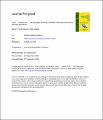The S … Hal and Se … Hal chalcogen bonding in a series of thiourea, selenourea and their derivatives
Chernysheva, M. V., & Haukka, M. (2021). The S … Hal and Se … Hal chalcogen bonding in a series of thiourea, selenourea and their derivatives. Journal of Solid State Chemistry, 293, Article 121759. https://doi.org/10.1016/j.jssc.2020.121759
Julkaistu sarjassa
Journal of Solid State ChemistryPäivämäärä
2021Tekijänoikeudet
© 2020 Elsevier
The chalcogen bonding (ChB) in a series of thiourea, selenourea and their derivatives has been investigated in the present paper. Thus, selenourea and dimethylselenourea undergo dimerization and trimerization processes in the presence of various halogen species (1–5). Selenourea and dimethylselenourea form trimers 3–4 in the presence of lighter halogens (chlorine and bromine) through Se⋯Se chalcogen bonding. When moving to heavier halogen (iodine), the dimers 1–2 are formed. Thiourea and its derivatives also tend to make very strong S⋯S bonds and form dimers in the case of lighter halogens chlorine and bromine (compounds 6–7). However, the monomers separated by the iodine species are formed upon interaction with iodine via very strong S⋯I bonding (compounds 9–12). Furthermore, among all the crystal structures of 1–12, only iodine cations I+ in 10 and 12 act as electron density acceptors, while in the remaining compounds 1–9 and 11 halogen species act as electron density donors.
Julkaisija
Elsevier BVISSN Hae Julkaisufoorumista
0022-4596Asiasanat
Julkaisu tutkimustietojärjestelmässä
https://converis.jyu.fi/converis/portal/detail/Publication/42545325
Metadata
Näytä kaikki kuvailutiedotKokoelmat
Lisenssi
Samankaltainen aineisto
Näytetään aineistoja, joilla on samankaltainen nimeke tai asiasanat.
-
Dihypoiodites stabilised by 4-ethylpyridine through O–I–N halogen bonds
Kramer, Eric; Yu, Shilin; Ward, Jas S.; Rissanen, Kari (Royal Society of Chemistry (RSC), 2021)Four bis(O–I–N) compounds have been synthesised from various dihypoiodites and 4-ethylpyridine. The compounds were characterised in both the solution and solid states by NMR spectroscopy (1H, 15N), X-ray diffraction, and ... -
Anion recognition by halogen bonding
Lehikoinen, Arttu (2022)Kirjallisuuskatsauksessa esitellään anionien tunnistus käsitteenä ja siihen liittyviä keskeisiä aiheita, ensisijaisesti halogeenisidos, käydään läpi. Myös halogeenisidosanionireseptorit ja niiden suunnittelun eri näkökulmat ... -
Short X···N Halogen Bonds With Hexamethylenetetraamine as the Acceptor
Anyfanti, Goulielmina; Bauzá, Antonio; Gentiluomo, Lorenzo; Rodrigues, João; Portalone, Gustavo; Frontera, Antonio; Rissanen, Kari; Puttreddy, Rakesh (Frontiers Media SA, 2021)Hexamethylenetetramine (HMTA) and N-haloimides form two types of short (imide)X···N and X–X···N (X = Br, I) halogen bonds. Nucleophilic substitution or ligand-exchange reaction on the peripheral X of X–X···N with the ... -
Hydrogen and Halogen Bond Mediated Coordination Polymers of Chloro-Substituted Pyrazin-2-Amine Copper(I) Bromide Complexes
Mailman, Aaron; Puttreddy, Rakesh; Lahtinen, Manu; Svahn, Noora; Rissanen, Kari (MDPI AG, 2020)A new class of six mono- (1; 3-Cl-, 2; 5-Cl-, 3; 6-Cl-) and di-(4; 3,6-Cl, 5; 5,6-Cl-, 6; 3,5-Cl-) chloro-substituted pyrazin-2-amine ligands (1–6) form complexes with copper (I) bromide, to give 1D and 2D coordination ... -
Halogen bonding and mechanochemistry combined : synthesis, characterization, and application of N-iodosaccharin pyridine complexes
Schumacher, Christian; Truong, Khai-Nghi; Ward, Jas S.; Puttreddy, Rakesh; Rajala, Anssi; Lassila, Elias; Bolm, Carsten; Rissanen, Kari (Royal Society of Chemistry (RSC), 2024)Halogen-bonded complexes are utilized across a myriad of synthetic chemistry fields, with halogen(I) complexes such as Barluenga's reagent being ubiquitous in halogenation reactions. The preparation of Barluenga's reagent ...
Ellei toisin mainittu, julkisesti saatavilla olevia JYX-metatietoja (poislukien tiivistelmät) saa vapaasti uudelleenkäyttää CC0-lisenssillä.

